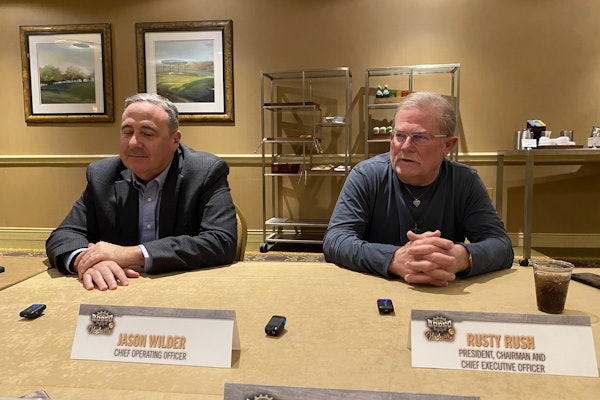
Moderated by David Foster of Southeastern Freight Lines, a six-team panel of technician educators, service managers and fleet maintenance managers gave their thoughts and advice on how to help service locations bring technicians into their business and keep them as employees.
One key, according to the panel, was eliminating the stigma of “grease monkey” when relating to diesel technicians, and letting prospective employees understand the career potential that is available in the heavy-duty trucking industry.
Kevin Tomlinson, director of maintenance for South Shore Transportation Company, said it is common for parents and school counselors to steer students away from technical trades; viewing those jobs as downgrade over business positions and other careers.
Thomas M. James, president and CEO of the Truck Renting and Leasing Association, said there are enough jobs available in the heavy-duty trucking technician industry to start pulling talented employees into the business once they realize that stigma is false.
“[Approximately] 40-50 percent of our technicians will retire in the next 15 years,” said James, “positions are out there.”
When it comes to recruiting technicians, the panel’s advice was clear: get involved with your area high schools, technician schools and your community. The more information you can provide to high school and college-aged students about the careers you offer, the more likely they are to inquire, and give technical schools a try.
“You have to show up at the schools and be vocal,” said Homer Hogg, senior technical trainer for T/A Petro Truck Service. “You have to let the school administrators know what you are doing and how you are helping.”
According to Timothy W. Lawrence, executive director for Skills USA, more than 40 percent of businesses are currently struggling to fill employment vacancies. So even if a service provider takes a proactive approach, they can’t expect to fill all of their openings immediately.
Lawrence said 45 percent of students participating in Skills USA courses enter the workforce after completing high school, and 36 percent move on to college. Once those students graduate, 72 percent of them enter the workforce, Lawrence said.
That means it can take several years to bring students you have worked with in high school into your business. Ray Wheeling, vice president of advanced training for UTI, said interaction and assistance for those students while they are in school is a good way to make them look at your business first when they decide to enter the workforce.
He said partnerships with schools to bring prospective students into your business and scholarships are great, but that cannot be all you do.
“Once you train someone, there has to be a chance for employment and incentives for your employees to stay,” he said.
The panel also said bringing in military veterans is a great way to build your technician workforce.
Wheeling said there are currently more than one million unemployed veterans looking for work in the United States, and a lot of those veterans have the perfect skills for this industry.
The biggest problem with hiring in the industry these days is finding people with basic employability skills, said Lawrence. Finding employees to show up on time is currently harder than finding employees who know to repair a wheel end.
Lawrence said military veterans have been extensively trained to be excellent at those specific employability skills.
“That is what they’ve been taught to do,” he said.









